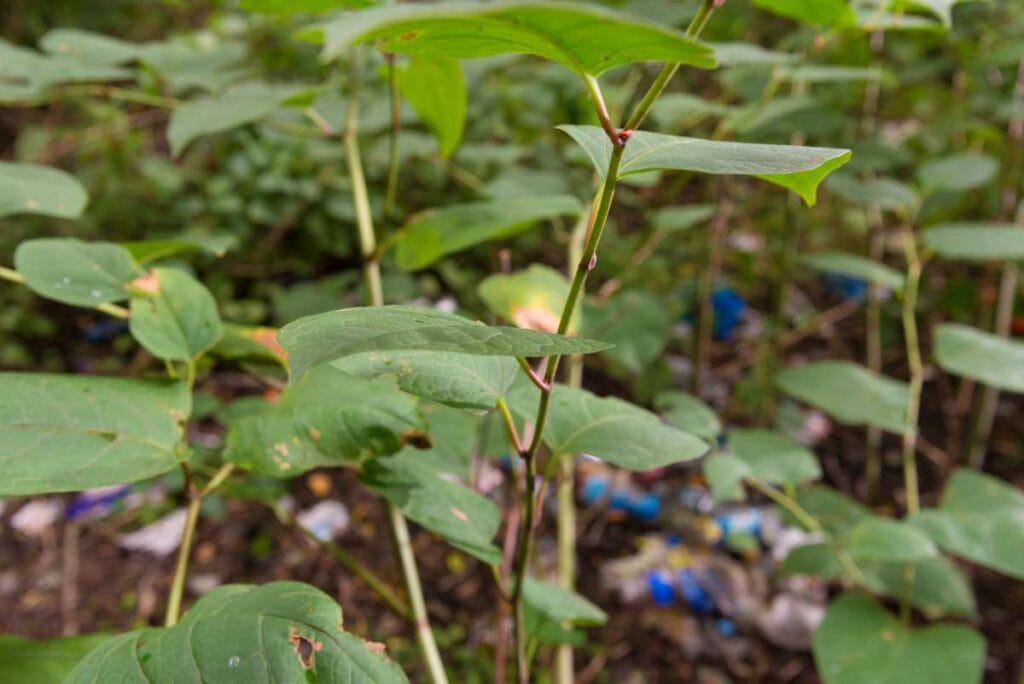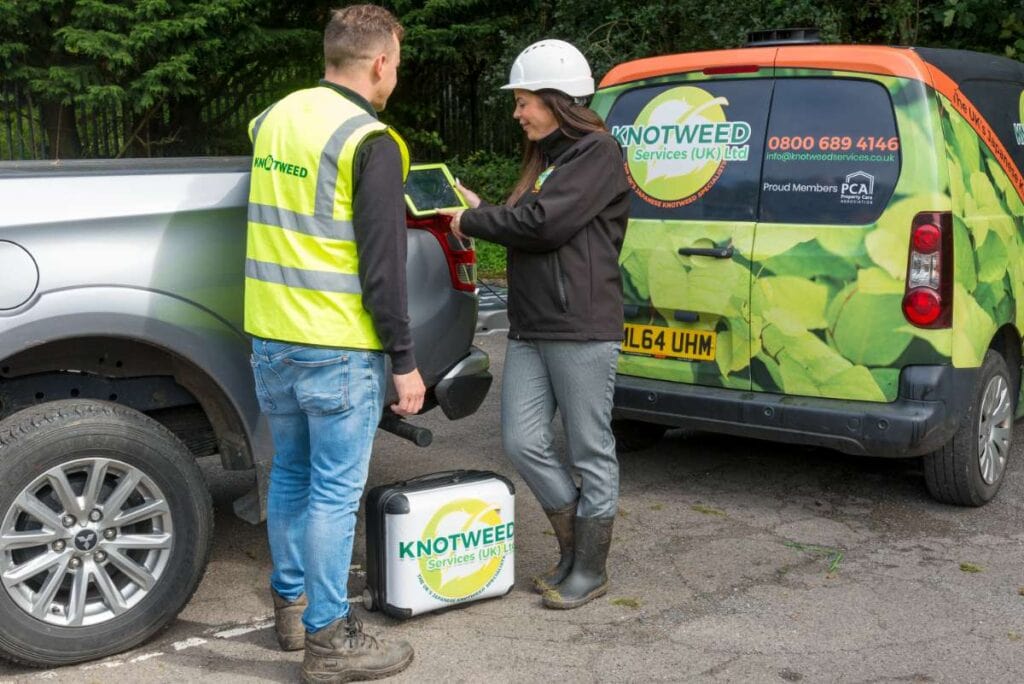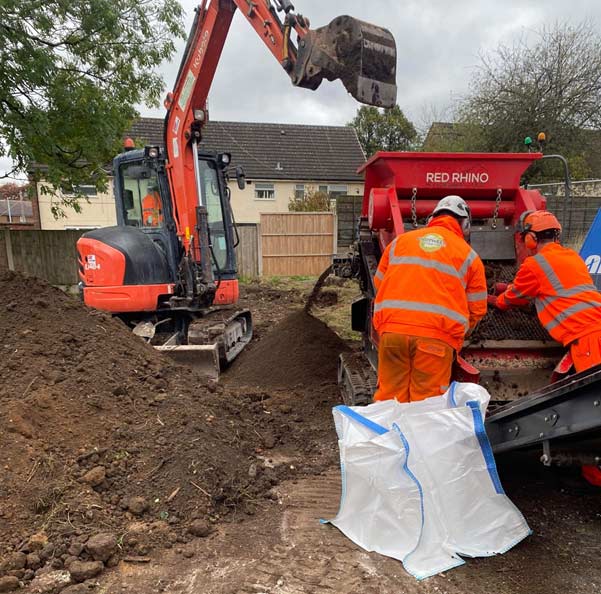JAPANESE KNOTWEED REMOVAL Bradford
10
LIVE KNOTWEED JOBS IN Bradford
51
SUCCESSFUL KNOTWEED REMOVAL PROJECTS IN Bradford
100%
SUCCESSFUL PROPERTY SALES AFTER TREATMENT
2
Bradford BASED KNOTWEED STAFF
Japanese knotweed treatment Bradford
Knotweed Services is a Japanese knotweed company based in the Midlands region, but with service offices in Bradford. We are well-versed in the complexities of Japanese knotweed removal, control, and treatment in and around Bradford and England.
Knotweed Services is a PCA member, a government-approved trade body for “the damp, waterproofing, wood preservation and invasive weeds industries.” If you have a knotweed problem, we’ll take care of it for you.
We have used our expertise in knotweed eradication to complete a number of challenging projects in and around Bradford and England. For knotweed removal to be successful, experienced identification, surveying, treatment, and control must take place. We can help.
Japanese Knotweed Bradford all – What You Need to Know
Homeowners, investors, and commercial property owners are affected by Japanese knotweed. If you’re a home owner, your lender probably won’t lend against a property with an infestation.
If you’re a land or property owner and Japanese Knotweed is present, the presence of the plant may delay construction projects.
Beware of Japanese Knotweed: What it is and What to Do About It
- Knotweed can grow through tarmac and concrete, threatening the structural integrity of buildings.
- Japanese Knotweed can prevent mortgage lenders from granting loans.
- Knotweed can obscure both visibility and access to roads, paths, and other infrastructure. For commercial properties in particular, the weed produces a major annoyance.
For customers in Bradford, who have Japanese Knotweed, they should call us right away. We’ll make sure the weed is removed completely and our warranty will ensure it doesn’t grow back.



FREE IDENTIFICATION
Fill in the form below, attach your pictures and we’ll let you know if the plant in your picture is Japanese Knotweed.
Call our professionals now to undertake the treatment and management of your infestation in Bradford
Call us on: 0121 725 6348 or 0800 689 4146 for an swift quote
From the first point of contact, Knotweed Services will support you through the entire process.
RESIDENTIAL JAPANESE KNOTWEED REMOVAL Bradford.
WHAT YOU NEED TO KNOW ABOUT JAPANESE KNOTWEED REMOVAL Bradford
Although Japanese knotweed infestations vary considerably from property to property, it’s common for homeowners to seek multiple methods of knotweed removal, treatment, and control.
As wild plants tend to be unpredictable, our weed control specialists assess a site’s specific factors to determine the type of treatments that will give the best results. We guarantee all our work.
— JAPANESE KNOTWEED REMOVAL OPTIONS AVAILABLE IN Bradford

FOLIAR SPRAYING *
We spray an herbicide containing chemicals on Japanese Knotweed, using a knapsack sprayer. We ensure that other plants aren’t damaged by spraying only when the weather conditions are suitable for the chemicals to work effectively. The most effective time for foliar spraying to Japanese Knotweed is in Spring.

FOLIAR LEAF WIPING *
With this Japanese knotweed treatment, we use a device to “physically wipe” our chemicals onto the leaves of the Japanese knotweed. Due to the precision of this application, we can frequently employ a greater chemical concentration.

STEM INJECTION
We apply a controlled amount of herbicide directly into the invasive weed. Due to being injected directly into the Japanese Knotweed, this is the most crafty method of removal. It isn’t dependent on the weather.

BIOMASS REDUCTION
Biomass is a sort of excavation and removal, but instead of excavating all of the soil affected by Japanese Knotweed, we simply remove the afflicted portions. It is an effective method of Japanese Knotweed control that allows for the reuse of the soil. minimising landfill usage.

CROWN REMOVAL
Crown and stems are capable of regeneration, and even minute fragments of clipped crown or stem are capable of regeneration and producing a new invasive weed — eliminating these components is a wonderful technique.
— COMMERCIAL TREATMENT OPTIONS AVAILABLE IN Bradford

SOIL SCREENING
A tried and tested methodology used on hundreds of sites across the UK.
Using the screening method, the Japanese knotweed rhizome material is separated from the soil material. The Japanese knotweed material is then either transported to licensed landfill at a much lower disposal rate or incinerated on site using a D6 exemption from the Environment Agency or Natural Resources Wales.
The cleaned soils can then be reused in locations away from any construction, normally in soft landscaping areas.
This can reduce the landfill & backfill requirement costs significantly and can also help to reduce the carbon footprint on site due to reduced vehicle movements to landfill.

BIOSECURITY SUPERVISION
To keep an eye on any digging or shifting of soil containing Japanese knotweed on your property, we can send a biosecurity worker.
We can set up a location where individuals can wash their boots and equipment at the site entry as a part of these precautions. We will supply the primary contractor with all toolbox discussions, which will be signed by all other contractors involved in the operation on site.
In locations where biosecurity is essential, we are able to offer temporary geotextile barriers.
After the service is over, we will deliver a thorough biosecurity report to the client.
This technique can be used in conjunction with other on-site therapeutic strategies.

EXCAVATION AND DISPOSAL
This treatment method is ideal where time constraints are present and there’s no other option other than to remove both the Japanese Knotweed and contaminated soil to a registered landfill.
By removing all traces of the infestation quickly, this offers a rapid solution to your problem and allows your commercial project to begin groundwork’s almost straight away. When time is of the essence, there is no quicker Japanese Knotweed removal/treatment method.
Any waste taken off-site will be done so with a licensed waste carrier to a suitably authorised landfill site.

CELL BURIAL
Cell burial comprises of moving Knotweed contaminated soil from one location on site, burying it in an excavated pit which is lined with a root barrier membrane, in a different position on the site.
The burial requirements for Japanese Knotweed are as follows:
- The Environment Agency recommends that the top of the burial cell should be a minimum of 2 metres below ground level.
- The overall depth of the burial pit should be in excess of 5 metres deep. All root barrier seams are welded together forming an encapsulated cell from which the Japanese Knotweed cannot escape. Clean soil is then used to backfill on top of the cell.
- To prevent accidental disturbance of the burial site, it is recorded on all site plans and future land owners should be made aware of the location.

STOCKPILE & TREAT
Bundling is a technique used to move contaminated Japanese Knotweed soil to another portion of the site that is being treated. A bund is a small, often 0.5m-deep region of contaminated soil.
For the surface of the bund to be flush with the surroundings, it can be raised, placed on top of the ground, or positioned inside an excavation.
The Japanese Knotweed will be relocated to a less-used region of the site thanks to the bund. When compared to where the Japanese knotweed was first found, this “buys time” for treatment.

HERBICIDE APPLICATION
At Knotweed Services we can provide the client with bespoke treatment plans depending on the locations of the Japanese knotweed.
These plans can work in conjunction with other methods of treatment where access is limited to pedestrian movements i.e., embankments or existing pathways within a site.
This will normally consist of up to 3 visits per annum to apply herbicide by either foliar spray technique or stem injection during the growing season over a period of 3 years, with a monitoring period of 2 years thereafter.
We would select the appropriate herbicides depending on the surrounding foliage or environmental constraints.
After each visit a full treatment record would be provided with photos showing the progress of the works and then an annual report.
